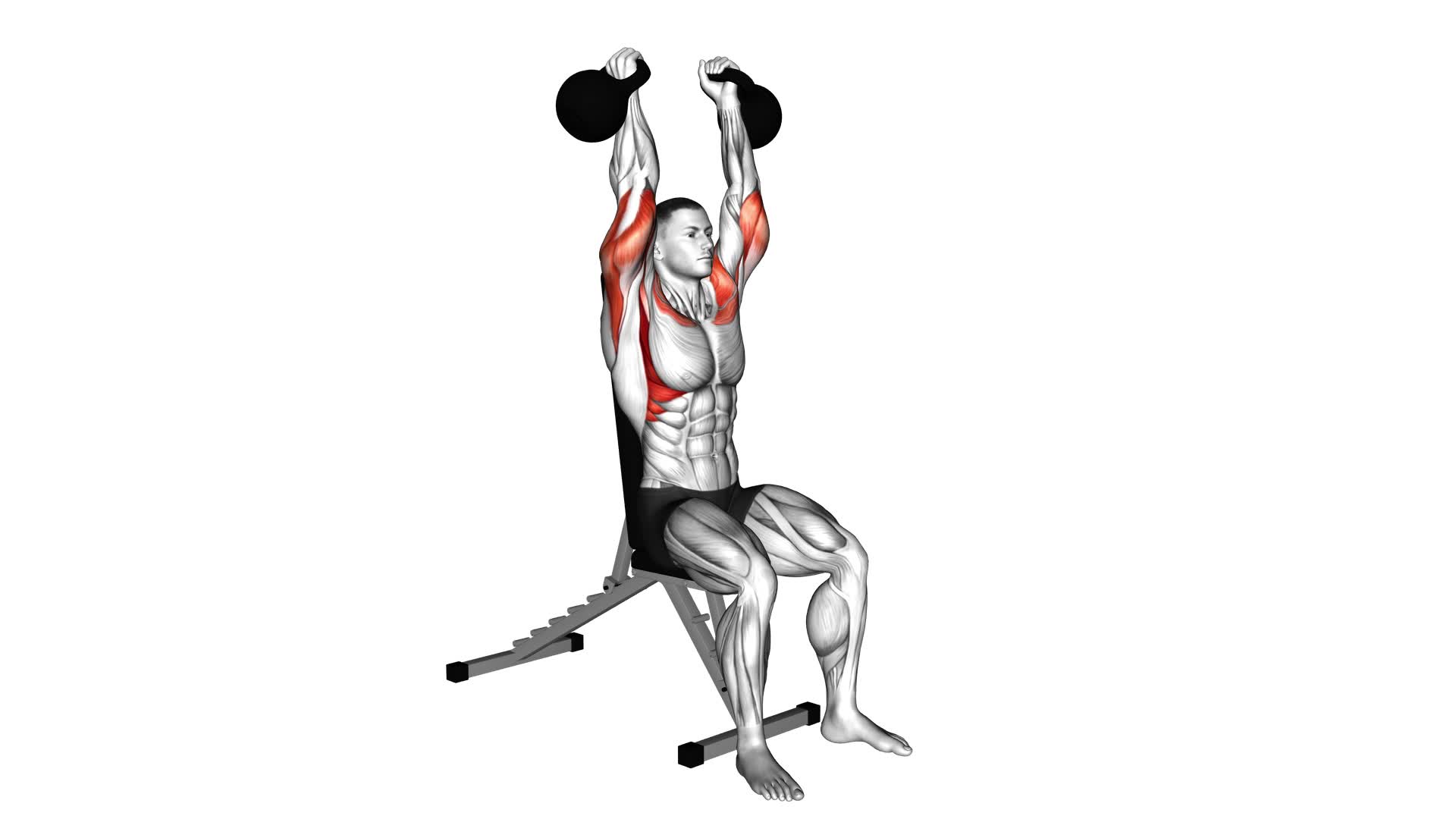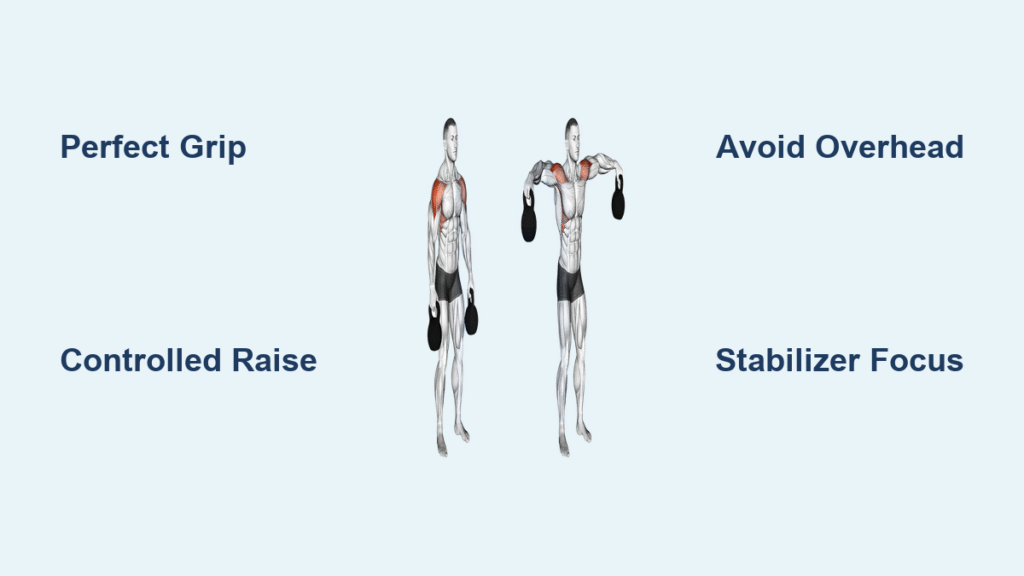Your shoulders burn as you struggle to lift those kettlebells sideways. The weight feels impossibly heavy, and you’re not sure if you’re doing it right. Kettlebell lateral raises challenge even experienced lifters because the weight sits below the handle, creating a unique mechanical disadvantage that demands perfect form. This movement serves as an effective tool for boosting upper body strength while simultaneously improving postural alignment.
This guide transforms your kettlebell lateral raise from frustrating to effective. You’ll learn exactly how to position your body, which weights work best, and why traditional dumbbells might actually serve you better for this movement. Forget generic shoulder exercises—the kettlebell lateral raise forces your stabilizing muscles to work overtime in ways standard dumbbell versions simply can’t match.
Why Kettlebells Make Lateral Raises So Difficult
The kettlebell’s offset weight distribution creates a longer lever arm than dumbbells. When you raise your arm sideways, that bottom-heavy kettlebell pulls harder against your shoulder joint. This design forces your stabilizing muscles to work overtime but severely limits how much weight you can safely lift. The unique loading pattern increases rotator cuff activation while reducing the load your deltoids can handle.
Most people discover they need kettlebells 30-50% lighter than their dumbbell lateral raise weight. Your shoulders will feel the burn much faster—what might be a comfortable 15-rep set with dumbbells becomes a challenging 8-10 reps with kettlebells. This mechanical disadvantage explains why many lifters abandon kettlebell lateral raises after one frustrating session.
How Kettlebell Weight Distribution Changes Everything
- Longer lever arm creates increased torque on the shoulder joint
- Bottom-heavy design forces stabilizer muscles to compensate
- Limited weight options make progressive overload difficult
- Grip demands shift focus from pure shoulder work to forearm engagement
Why You Might Feel It More in Your Rotator Cuff
The kettlebell’s unique loading pattern places unusual stress on your shoulder joint. Instead of the weight traveling in a smooth arc like with dumbbells, the kettlebell’s center of gravity shifts during the movement. This requires constant micro-adjustments from your rotator cuff muscles, making it more of a stability exercise than a traditional strength builder.
Essential Equipment Setup for Success

Choosing Right Kettlebell Weights
Select kettlebells that feel almost embarrassingly light. Most men start with 8-12kg, while women typically begin with 4-8kg. The mechanical disadvantage amplifies the perceived weight significantly—what feels easy with dumbbells becomes challenging with kettlebells. Your goal isn’t to lift heavy but to maintain perfect form throughout the movement.
Perfect Grip Positioning
Hold the kettlebell handle in the center with a neutral grip (palms facing your thighs). The bell should hang below your hand, creating that distinctive offset loading. Wrap your fingers firmly around the handle, but avoid death-gripping—tension travels up your arm and compromises shoulder mechanics. Keep your wrists straight and strong throughout the movement.
Perfect Form Execution for Maximum Shoulder Activation
Starting Stance for Stability
Stand with feet shoulder-width apart, knees slightly bent. Hold kettlebells at your sides with arms fully extended. Engage your core by imagining you’re about to take a punch to the stomach. This creates the stable base your shoulders need to perform the movement without compensating. Keep your chest up and gaze forward—never look down at your feet.
The Raise Technique That Actually Works
Initiate the movement by taking a deep breath. Slowly raise both arms out to the sides, keeping elbows slightly bent throughout. Imagine leading with your elbows rather than your hands—this prevents the common mistake of internally rotating your shoulders. Stop when your arms reach shoulder height. Your body should form a perfect “T” shape. Never lift above shoulder level—this puts unnecessary strain on the joint.
Critical Form Breaks That Sabotage Results
Watch for these red flags that turn your kettlebell lateral raise into a shoulder injury waiting to happen:
– Leaning back at the top position (shifts focus to traps)
– Shrugging shoulders toward your ears (reduces deltoid activation)
– Swinging the weights up using momentum (eliminates muscle tension)
– Rotating palms forward or backward (creates shoulder impingement risk)
– Bending elbows excessively (turns it into a front raise)
Advanced Technique Variations for Shoulder Growth

Forward Lean Method for Rear Delt Focus
Slight forward torso lean shifts emphasis toward your rear deltoids. Lean forward 10-15 degrees from the hips, maintaining neutral spine. This variation reduces front delt involvement and intensifies upper back engagement. Keep your core tight to prevent lower back strain during this modified kettlebell lateral raise.
Time Under Tension Protocol
Instead of increasing weight, extend the duration. Hold at the top for 3-5 seconds, then take 4-5 seconds to lower. This progression method works around kettlebell’s limited weight increments while building serious muscular endurance. Research shows eccentrics create more muscle damage and subsequent growth—even with light weights.
Extended Arm Challenge for Serious Stability
Hold the kettlebell by the “horns” (sides of the handle) with arms extended in front of you. This grip position keeps the weight further from your body, dramatically increasing the lever arm. Start with half your normal weight—this variation humbles even advanced lifters and provides incredible shoulder stability benefits.
Expert Controversy: Should You Even Do Kettlebell Lateral Raises?

Marc, a respected strength coach, pulls no punches: “You can’t really do lateral raises with a kettlebell. The weight will be severely limited due to the long lever.” His blunt assessment reflects widespread expert opinion—traditional dumbbells simply work better for this movement pattern. The kettlebell’s design creates such a mechanical disadvantage that you’re better off using other equipment for pure shoulder development.
Pavel Macek, another renowned trainer, is even more direct: “Lateral raises are not on my list of priorities — they’re not even in my list.” These experts recommend alternative movements that better utilize kettlebell’s unique properties while building shoulder strength more effectively.
Superior Kettlebell Alternatives for Shoulder Development
Consider these kettlebell-specific movements instead:
– Side raise snatches from Rise of the Kettlebell program
– Double kettlebell side snatches for advanced practitioners
– Lateral holds—static holds at shoulder height for time-based progression
– Kettlebell overhead presses for functional shoulder strength
Safety Guidelines to Prevent Shoulder Injuries
Shoulder Health Check Before Starting
Before attempting kettlebell lateral raises, assess your shoulder mobility. Can you raise both arms overhead without arching your lower back? If not, address mobility restrictions first. The leveraged load from kettlebells can aggravate existing impingements and create long-term issues.
Critical Warm-up Protocol
Perform 2-3 sets of arm circles—10 forward, 10 backward—followed by band pull-aparts. These movements activate your rotator cuff and prepare the shoulder joint for the unusual loading pattern. Never skip this step—cold shoulders meeting kettlebell leverage equals injury risk.
Warning Signs That Require Immediate Stop
Immediately stop if you experience:
– Sharp pain in shoulder joint (not muscle burn)
– Numbness or tingling down your arm
– Inability to maintain controlled movement
– Audible clicking or popping sounds
Programming Your Kettlebell Lateral Raises Effectively
Optimal Training Frequency
Limit kettlebell lateral raises to 1-2 times per week. The unique loading creates significant joint stress despite lighter weights. Allow 48-72 hours recovery between sessions. Your shoulders need this time to adapt to the unusual stabilization demands.
Set and Rep Schemes for Your Goals
- Endurance focus: 2-3 sets of 15-20 reps (light weight, perfect form)
- Hypertrophy focus: 3-4 sets of 10-12 reps (moderate weight, controlled tempo)
- Strength focus: 4-5 sets of 6-8 reps (very light weight, maximum tension)
Smart Program Placement
Use kettlebell lateral raises as a finisher after heavier pressing movements. The pre-fatigued shoulders respond better to the high-rep, stability-focused nature of this exercise. Never start your shoulder workout with these—the form breaks down quickly under fatigue, increasing injury risk.
Final Considerations for Shoulder Development
Kettlebell lateral raises serve as an interesting variation but shouldn’t form your primary shoulder training. The unique loading challenges stabilizers while severely limiting progressive overload potential. Consider them an occasional finisher rather than a staple movement.
For consistent shoulder development, rotate between kettlebell variations and traditional dumbbell lateral raises. This approach provides stability benefits while ensuring you can progressively overload your deltoids for continued growth.
Remember: the best exercise is the one you can perform pain-free with perfect form. If kettlebell lateral raises cause discomfort despite technique adjustments, stick with dumbbells or explore the expert-recommended alternatives. Your shoulders will thank you for prioritizing long-term health over short-term ego lifting.




